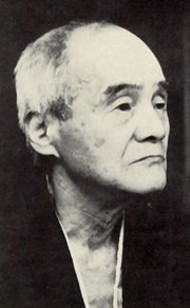Hajime Tanabe | |
|---|---|
| 田辺 元 | |
 | |
| Born | February 3, 1885 |
| Died | April 29, 1962 (aged 77) |
| Nationality | |
| Alma mater | Tokyo Imperial University |
| Notable work | ‘The Logic of Species and the World Schema’, Philosophy as a Way to Repentance (Metanoetics) |
| Awards | Order of Culture |
| Era | 20th-century philosophy |
| Region | Japanese philosophy |
| School | |
| Institutions | |
Main interests | Philosophy of Science, Philosophy of Mathematics, Philosophy of Physics, Metaphysics, Philosophy of Religion |
Notable ideas |
|
| The Kyoto School of Philosophy |
|---|
| at Kyoto University |
| Topics |
| Individuals |
| Historical background |
Hajime Tanabe (田辺 元, Tanabe Hajime, February 3, 1885 – April 29, 1962) was a Japanese philosopher of science, particularly of mathematics and physics. His work brought together elements of Buddhism, scientific thought, Western philosophy, Christianity, and Marxism.[1] In the postwar years, Tanabe coined the concept of metanoetics, proposing that the limits of speculative philosophy and reason must be surpassed by metanoia.
Tanabe was a key member of what has become known in the West as the Kyoto School, alongside philosophers Kitaro Nishida (also Tanabe's teacher)[2] and Keiji Nishitani.[3][4] He taught at Tōhoku Imperial University beginning in 1913 and later at Kyōto Imperial University, and studied at the universities of Berlin, Leipzig, and Freiburg in the 1920s under figures such as Edmund Husserl and Martin Heidegger.[1] In 1947 he became a member of the Japan Academy, and in 1950 he received the Order of Cultural Merit.
- ^ a b The Editors. "Tanabe Hajime, Japanese philosopher". Encyclopaedia Britannica. Retrieved 3 July 2023.
{{cite web}}:|last1=has generic name (help) - ^ Shaw, Kendrick. "Zen Buddhism: The Kyoto School". University at Buffalo. Retrieved June 25, 2010.
- ^ Davis, Bret W. (2019), "The Kyoto School", in Zalta, Edward N. (ed.), The Stanford Encyclopedia of Philosophy (Summer 2019 ed.), Metaphysics Research Lab, Stanford University, retrieved 2020-06-24
- ^ Flanagan, Damian (2019-02-09). "'Philosophers of Nothingness': Philosophy built on quietly gripping human dramas". The Japan Times. Retrieved 2020-06-24.